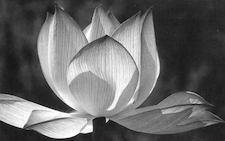
Throughout early history, in Asia and much of the ancient Near East, the lotus was associated with the sacred. The ancient Persians viewed the open lotus flower as a symbol of the sun, the giver of life, and the Phoenicians depicted it being borne to heaven on wings, surrounded by the moon and stars. In China the lotus was esteemed, not only for religious reasons, but for medicinal use and as food. The profusion of gorgeous lotuses in the many lakes and waterways of China have been the source of inspiration of Chinese poets for centuries. Robert Graves, in The White Goddess, recounts a Greek myth of the half god, half mortal hero Hercules, who borrows a lotus-shaped golden cup of the sun.
In the myths and legends of ancient Egypt, the lotus is a recurring theme. The king of the Egyptian gods, Osiris, judge of the dead, wore a crown of lotus blossoms, and Isis, his queen, was represented by the budding lotus. Another myth depicts the god Horus being reborn each day from a blossoming lotus. The Egyptians also thought that stalks of the lotus plant supported the heavens, emulating this by carving lotuses on the columns that supported the roofs of their temples.
The lotus has been especially revered in India. One Hindu creation legend is an interesting parallel to the Egyptian story. A golden lotus arises from the primal water, and as it opens Brahma, Vishnu, and Shiva emerge from the flower’s center. According to Hindu belief, the core of the lotus is the center of great vitality and power. An early Indian literary work, the Rig Veda, tells of the ancient Indian mother goddess “Lotus Goddess Lakshmi,” alluding to her as “the mother of created beings.” Another name for Lakshmi is Padma, or “lotus”, and she is called the “lotus-born,” “lotus-eyed,” and “lotus-colored” and is often depicted standing above or seated upon a lotus.
The Buddha, in his enlightenment state, is often portrayed seated upon an open lotus flower, and in all the forms of Buddhism the lotus is symbolic of the highest spiritual attainment. In Asian art works, buddhas and bodhisattvas are frequently shown seated on lotus flowers. Kwan Yin, the Chinese bodhisattva of mercy, is represented carrying a lotus in her arms. There is a legend about the revered teacher, Padma Sambhava, also known as Guru Rinpoche, who introduced Buddhism to Tibet in 762 AD. His name which means “Preacher of the Lotus” originated from the Sanskrit word “Padma,” or lotus. Long ago in India, Padma meditated with his wife, a beautiful princess named Mandarava. The king became so furious when he learned that Padma had converted his daughter to the Buddhist faith that he had Padma seized and burned alive. But, when the king’s soldiers returned to collect the charred remains of his body, they discovered that Padma Sambhava was still very much alive and meditating on a magnificent lotus above a lake. From that time forth, this very spot has been known as Tso (“lake”), Pema (“lotus”).
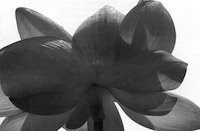
During the last eight years of his life, Shakyamuni Buddha preached the sutra Saddharma-Pundarika which is Sanskrit for “The Lotus of the Wonderful Law.” At that time the Buddha sat with his legs crossed in what is now known as the lotus position, and while meditating in this position, he entered into a state where his mind and body never moved. Then, he announced to his disciples that he had “not yet revealed the truth” and predicted that the lotus teaching would be propagated in the distant future when the world is defiled by the poisons of stupidity, greed, and anger and all other teachings have lost their capacity to save mankind. We do not know what language the Lotus Sutra was originally preached, but it was translated into Chinese from Sanskrit by the Central Asian scholar-monk Kumarajiva (344-413 AD) and later translated into Japanese and English. Today, the chanting of “Nam Myoho Renge Kyo” from the Lotus Sutra as taught by the priest Nichiren is practiced worldwide. Renge literally translates as lotus but the mystic meaning is hidden within the teaching. The text of the Lotus Sutra refers to thousands of lotus blossoms, and it is said that the roots of goodness are planted deeply to save living beings, a Mahayana Buddhist vow.
The Dalai Lama, leader of Tibetan Buddhists, is known as the “Lord of the White Lotus” because the color white is made up of all other colors and is the symbol of spiritual perfection. Many mandalas used in meditation are stylized lotus flowers representing the wheel of birth, death, and rebirth. Shambhala, the pure land depicted in Tibetan Buddhism, is portrayed in the shape of a lotus flower with eight petals, representing the eightfold path of the Buddhist. The Tibetan Buddhist teaching of the sacredness of reality considers five styles of energy also called five Buddha families. One is the padma lotus family which has both enlightened and negative associations. The padma is symbolized by a beautiful delicate lotus which emerges from the mud. It emits energy in the form of passion, its color is red, and the negative aspect is described as clinging and grasping, the deluded side of passion. But, when the passion energy is freed of fixation, it turns into discriminating awareness and has the wisdom of experience. The positive enlightened state of the heat of padma passion is the warmth of genuine compassion.
What is this almost magical plant that has inspired so much reverence and so many legends over the centuries? What is the reason for its great symbolic power? The botanical family of the lotus is Nymphaeacea, the water-lily family, which is made up of nine genera and about fifty or sixty species. These are aquatic plants which grow from rhizomes buried in mud at the bottom of lakes and ponds; when the temperature is warm enough they send up petioles or stalks to the water’s surface. From these grow large jade green leaves which repel drops of water on the surface, then flowers rise up which often span ten to twelve inches, and leaves and flowers can tower higher than the average person. The flowers open at dawn and close again at sunset.
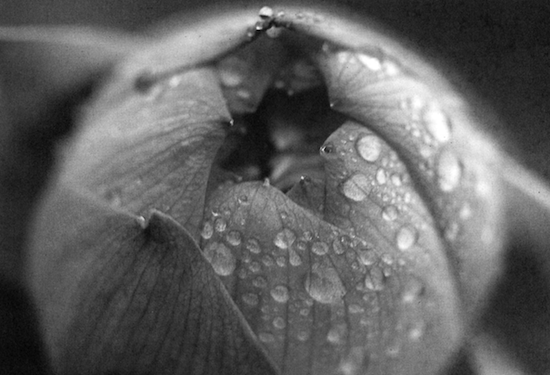
The name “lotus” causes a certain confusion, since it is used for plants within the family which are not true lotuses. The “lotus” of ancient Egypt was actually a water lily, Nymphaea caerulea, the blue lotus. There is still another blue lotus in India (N. stellata) which is probably the same lotus that the Greeks used as an ornamental element in their architecture. “Lotus” is also a name used commonly for the trefoil, which is grown in many parts of the world. In the United States, we are most familiar with the pond lily, Nuphar, which grows throughout North America. But it is the genus Nelumbo that contains the sacred lotus of Asia.
The American lotus Nelumbo is the Nelumbo lutea which grows in the eastern United States from Minnesota to Florida and westward to eastern Texas. It has bluish green leaves that span one to two feet across and deep yellow flowers that grow to about a foot in diameter. It grows to a height of two and a half feet. Its seed pods are yellow when they are young, later turning to green. The Indians used the rhizomes of the Nelumbo lutea for food, cooking them like potatoes and boiling the seeds when they were green for eating.
Nelumbo nucifera—the well known “sacred lotus” or “Hindu lotus”—grows in tropical Asia. It is this lotus that is shown holding the seated Buddha. Its leaves are three feet across and range from a deep yellow green to a true green. When it is grown, a few of its leaves lie flat on the surface of the water, like a water lily, and the rest stand anywhere from a foot to five feet above the water. The leaves are coated with a waxy substance that makes them completely water repellent.
The flowers of Nelumbo nucifera are larger than the American Nelumbo lutea, greater than a foot across. They have a wonderful full fragrance, are usually white, rose, red, or various combinations of these colors, and they can grow over six feet high.
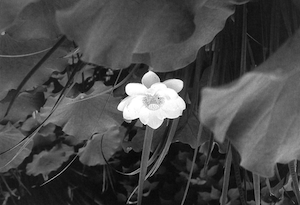
The seed pod is one of the lotus’s most distinctive parts. It is a large, flat topped receptacle, resembling as one writer pointed out, a small watering can! When the pods dry out, they are long lasting and are often used in flower arrangements, or, with their empty seed containers, as a purely decorative element, sometimes gilded.
Almost all of the plant is used for food: the stalk is sometimes served cold in salads; the root is cooked in many different ways; and the seeds can be either cooked or eaten fresh like nuts. The leaves are used as wraps for steaming food. In Japan, even the flower, which is bitter, is used in tempura.
All lotuses bloom in the daytime, usually for three days, although several last a few days longer. They open early in the morning and close towards the end of afternoon, closing earlier on the first day, interestingly enough. With most Nelumbo, on the fourth day of bloom the flowers fall off, leaving the seed pod standing. The pods stand until they dry out enough to become brittle, then break off and flower on the water until they rot, at which point the seeds fall, sink, and germinate in the mud at the bottom.
Researchers have found that one of the most striking attributes of the lotus is a remarkable ability to adjust its temperature. As the sun sets and the air cools, the lotus produces enough energy to raise its temperature. And when the sun rises, the lotus’s heat subsides. A single lotus flower can produce one watt of energy and forty plants generate the equivalent energy of one light bulb! The energy that was attributed to the lotus in early Vedic Hinduism actually exists.
It is clear that the manner in which the lotus grows is the main reason for the reverence in which it is held. It begins in the mud, where its rhizome is buried; then the petiole makes its way up through murky water toward the surface; once it has reached the air, high above the water in clear light, an unsullied blossom opens among the leaves that themselves are untouched by the water. What better image for the journey of the soul, born in ignorance and mired in the material world, seeking enlightenment on its passage though life; what better display of tranquillity than the great green leaves lying quietly on the water with the splendid blossom glowing in the air above them?
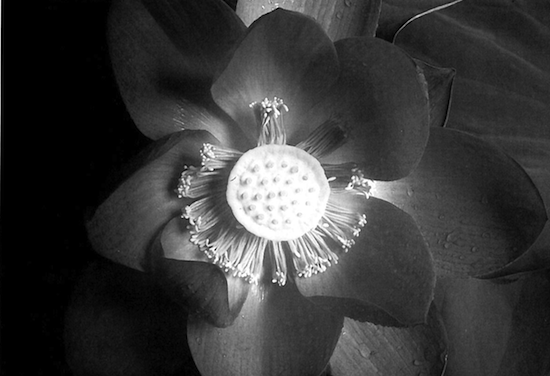
Poems
The moon’s the same old moon,
The flowers exactly as they were,
Yet I’ve become the thingness
of all the things I see!
Bunan (1602-1676)
Whoever in this world overcomes his selfish cravings,
his sorrows fall away from him,
like drops of water from a lotus flower.
From the Dhammapada. Early Buddhist teachings.
When you contemplate the waters
at day break, you can hear
the lotus blossom.
Kyokusai (1816-1874)
He drifts on blue water
under a clear moon,
picking white lilies on South Lake.
Every lotus blossom speaks of love
until his heart will break.
Li Po (701-762)
I cook the lotus soup,
Slice fine the lotus roots
I await my husband’s return
to relieve the hunger.
If he should covet
pairs of chopsticks elsewhere
Just so he forgets not
The key in his heart.
Hung Tsun-hsien (1848-1905)